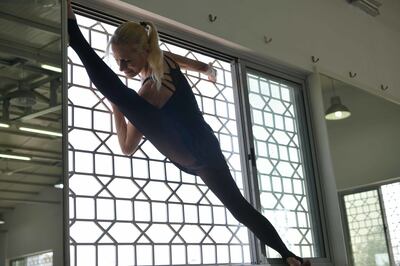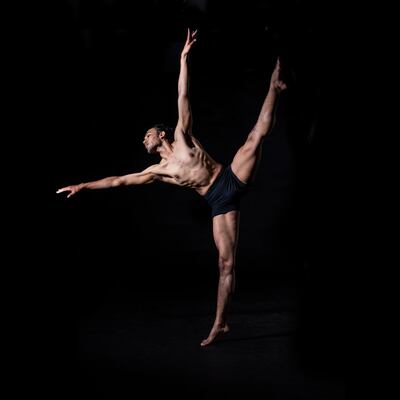Tejas Saraswathi’s grandmother is a wise woman. When Saraswathi was about to quit ballet because of the constant bullying from his friends, she advised him against it.
“If you give up this opportunity, you will be making a big mistake,” she said, acknowledging the fact that professional ballet schools are not very common in India.
“She was right. Everybody does contemporary and hip-hop. But boys doing ballet here … that's pretty rare," Saraswathi says. "That's when I decided to stop listening to other people who were out there to hurt me. I just followed my heart.”
Now he believes continuing the practice was the best decision of his life.
Saraswathi was studying in Bangalore at the Parikrma Foundation, a non-government organisation that provides free education to orphans and children from slums. He was introduced to ballet through an outreach programme run by The Lewis Foundation of Classical Ballet.

“I had no idea what ballet was when I was young. Since I come from a not-so-privileged family, I didn’t have much exposure to the arts. But the thought of learning a new dance form excited me. Boys in India don't prefer ballet. So, I thought let me give it a try and do something new and unique,” he adds. Today, Saraswathi has completed 12 years of ballet training, with several shows in Bangalore and Delhi to his credit.
What keeps the 19-year-old pursuing the dance is the combination of physical and mental strength it has helped him develop.
“While physically, ballet has helped build my agility and strength, mentally and emotionally it has helped me overcome stage fear. It helps me deal with exam stress better as well,” he says, adding that although he may not make a career out of dancing, he does plan to pursue physiotherapy in sport and dance. “This way, I can help and heal in the two fields that I love the most.”
Saraswathi is one of 200 boys who were provided ballet training and performance opportunities by The Lewis Foundation, through its partnership with NGOs such as the Parikrma Foundation and Snehadaan.
Established in 2006, The Lewis Foundation trains in various dance forms, including ballet, jazz, modern and other disciplines. It has more than 1,000 students at its six centres in Bangalore and the outreach weekly class at Parikrma Foundation. The male-to-female ratio is 34:1,000.

Yana Lewis, The Lewis Foundation's artistic director, co-founder and head teacher, believes that when people think of ballet, they think only of pointe work, where you support all your body weight on the tips of fully extended feet.
“Men, in ballet, are athletes,” she says, adding that, although things have improved over the years on the gender front, there is still more that could be done. But when asked if the skewed gender-ratio is India-specific when it comes to ballet, she is quick to reply that it is global.
Lewis is accredited by the Imperial Society of Teachers of Dancing in the UK. She has trained in classical ballet under Jean Campbell, Molly Lake and Celia Johnson and in jazz under Ivor Meggido and Arlene Phillips. She is also trained in modern techniques developed by dancing greats such as Merce Cunningham, Martha Graham, Lester Horton and Jose Limon. Lewis has choreographed for or featured in music videos for Elton John, Bryan Adams, Phil Collins and Ray Parker Jr.
The Lewis Foundation is credited with getting many students on to the path of ballet, and many have moved abroad to pursue further training. Rahul Pradeep, 32, is one of them. Pradeep started learning ballet at the age of 20, although he remembers being fascinated by it when he was seven.
“The flexibility, grace and power of dance intrigued me. As a boy, my parents always tried to push me into sports, as most parents do. But I preferred combining musical sensibilities and athletic prowess through ballet. Music is my first love and dance was the perfect engine to drive this passion,” he says.

Pradeep was offered scholarships to study at the Royal Conservatoire of Scotland and Ballet West Scotland where he was a part of the Ballet West Touring Company with national tours of Scotland. He has Bachelor of Arts degrees in ballet and musical theatre. Ask him if his journey as a male ballet dancer was a tough one and he smiles.
“Picking ballet was one of the easiest decisions I have ever made in my life. It gave me the freedom to leave everything I didn’t need behind, and push forward to what dance had to offer me. I leapt and have never looked back.” Pradeep is currently based in London.
Ballet helped Anand Dhanakoti, 31, realise his true calling as well. Today he lives in Hamburg, Germany and is pursuing a career as a freelance dancer and choreographer.
“Initially, I found the intricate movements in ballet difficult. But my curiosity drove me to master the art, and I grew to adore expressing myself through ballet," he says. Dhanakoti started learning ballet at the age of 13 and continued doing so for a decade.
Initially, societal prejudices challenged Dhanakoti, who had always studied at an all-boys school. “The ballet attire felt more feminine, making me slightly uncomfortable. However, my teacher’s support helped me overcome these hesitations. It took about two years for me to become more aware of my body and envision myself as a ballet dancer,” he adds.
Ballet led Dhanakoti to explore Indian folk dance, street circus, Kalari, flying, passing through, jazz and hip-hop as well. He eventually shifted to contemporary dance because he was fascinated by its movements. “It allowed me to explore classical and modern styles, fostering my desire to not just be a ballet dancer but a versatile artist, creating my own works as a choreographer," he says. Dhanakoti has had the opportunity to travel and collaborate with dance communities globally, from Poland to Japan.
Germany lured another ballet dancer, Peter Mani, too. Mani was selected for a three-year dance programme at the Contemporary Dance School in Hamburg. Like Dhanakoti, he had to use a crowdfunding platform to sponsor his ambition. His father was a daily wage labourer whose tuberculosis treatment pushed the family into the trap of money-lenders. Mani had to drop out of school and start earning for his family at the age of eight, building roads, parks and drainage. Mani was eventually helped by an NGO, through which he got a scholarship to take up ballet aged 12.
“From being someone who worked on the streets and couldn’t speak English, I became someone who not only graduated from a reputed college as the best outgoing student but also became an assistant teacher in ballet. The discipline that I learnt in ballet helped me cope with my life. Dance has given my life a direction and a purpose. I don’t intend to ever stop dancing,” Mani says.
The journey of many of these male ballet dancers is reflected in films such as the 2020 Netflix documentary/drama by Sooni Taraporevala, Yeh Ballet, and 2023 documentary Call Me Dancer. While the former drama film showcased the journey of two underprivileged boys from Mumbai, who pursue their ballet dreams despite all odds, the latter is a documentary that follows the trials of Manish Chauhan, who wants to be known as a dancer, despite his humble beginnings in Mumbai’s slums.
Chauhan followed his passion although his parents wanted him to have a stable career and complete his education. The story highlights the fact that dancing is not an investment the poor could afford and Chauhan was fortunate to have been spotted, trained and encouraged by Israeli ballet teacher Yehuda Maor.
Call Me Dancer has won several awards in independent and international film festivals this year, including the Audience Award at the Vancouver International Film Festival, Berkshire International Film Festival and Tasveer South Asian Film Festival.
It's said that dancers don’t need wings to fly. The grit of these ballet dancers in pursuing their passion, notwithstanding their roots and societal expectations, is a reflection of that.






